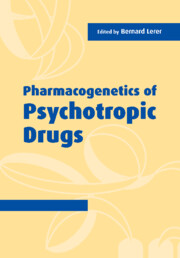Book contents
- Frontmatter
- Contents
- List of contributors
- Part I Introduction
- Part II Clinical background and research design
- Part III Molecular background
- Part IV Pharmacokinetics
- Part V Specific psychotropic drugs and disorders
- Part VI Pharmacogenetics and brain imaging
- Part VII Industry perspectives
- 20 Pharmacogenetics in psychotropic drug discovery and development
- 21 High-throughput single nucleotide polymorphism genotyping
- Index
20 - Pharmacogenetics in psychotropic drug discovery and development
from Part VII - Industry perspectives
Published online by Cambridge University Press: 20 August 2009
- Frontmatter
- Contents
- List of contributors
- Part I Introduction
- Part II Clinical background and research design
- Part III Molecular background
- Part IV Pharmacokinetics
- Part V Specific psychotropic drugs and disorders
- Part VI Pharmacogenetics and brain imaging
- Part VII Industry perspectives
- 20 Pharmacogenetics in psychotropic drug discovery and development
- 21 High-throughput single nucleotide polymorphism genotyping
- Index
Summary
OVERVIEW
The field of pharmacogenetics impacts all stages of psychotropic drug development. At the level of discovering novel molecular sites of action and screening hundreds of thousands of compounds to find “hits” for these novel targets, the techniques of genomics, proteomics, and molecular biology are now routinely utilized. The vision for the future is that pharmacogenetics will permit matching an individual patient genotype to the specific therapeutic agent that will produce the greatest benefit with the least number of side effects. While industry-sponsored clinical trials present a real opportunity to pursue this vision, ethical and economic hurdles impede progress. The economic hurdles will remain a major barrier until examples of success attract larger investments from the pharmaceutical industry. From the viewpoint of drug development, the only generalizable success to-date has been understanding the genetic basis of variation in drug metabolism. Some convincing instances of predicting susceptibility to side effects has recently emerged. But, putative genetic predictors of response in neuropsychiatric disorders have either limited applicability or uncertainty and so they cannot reliably be applied to enrich populations for trials or understand variations in outcome. Given this situation, joint academic–government–industry efforts may provide a means of sharing risks and accelerating research in this promising arena.
Introduction
The 1990s provided a range of new molecular genetic techniques that should ultimately allow identification of the best available pharmacological treatment for each patient.
Keywords
- Type
- Chapter
- Information
- Pharmacogenetics of Psychotropic Drugs , pp. 403 - 421Publisher: Cambridge University PressPrint publication year: 2002



